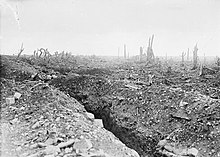Laufgraben (trench warfare)

A trench (also known as a connecting trench ) is a field fortification in the form of a simple trench that connects the hinterland with the foremost front line and offers protection from rifle bullets and shrapnel. In contrast to the trenches , a trench is only used for active combat in exceptional cases; He is therefore not with loopholes or appearances equipped. A trench is also not intended for the permanent stay of soldiers under fire; it therefore normally offers no protection against direct hits due to the lack of shelters or bunkers . Trenches are part of trench warfare and are only used during long periods of static warfare. Especially often they were in grave war in World War .
Function and use
The main function of the trench is to enable the covered transport of food , ammunition and other supplies to the main battle line, the transport of the wounded, the covered supply of replacements as well as the arrival and departure of soldiers and officers, from detectors , artillery observers and inspectors up to complete Infantry units from the front line when releasing them.
Trenches were so narrow that formations could only pass them in rifle lines. Due to the frequent traverses and the limited view - unit changes were carried out at night - there were delays and accelerations, which led to the accordion effect in larger formations . Whenever trenches crossed, entire parts of units could get lost. It was therefore recommended that the front of the line in the trench should only march at a leisurely pace and, in the case of inexperienced troops, stop regularly until the end had caught up.
Plant and construction
The main direction of the trench forms an angle to the main battle line. In order to shorten the length of the trench, its main direction is ideally at right angles to the main battle line, but the characteristics of the terrain and the enemy's weapons can also dictate more acute angles. While the main direction dictated the general course of the ditch, the local direction deviated from it through regular traverses and changes of direction. A straight section of a trench should not be longer than 12 m during the First World War in order to limit the effect of a shell hit on this section. Trenches could reach a length of up to two kilometers and were made deeper the closer the front was.
In the First World War, trenches about 1.50 m deep below the earth's surface were the norm. Because of the lack of loopholes and in order to save time with the digging work, the cross-section is usually narrower than that of the trenches. The trenches were approx. 0.90 m wide at the upper cross-section and were dug with as little slope as the angle of repose of the soil allowed. In the ideal case, the trench walls fell almost vertically, which in addition to the reduced amount of excavation also provided better protection against shrapnel. The excavated earth was thrown into a parapet on both sides of the trench , both sides were about the same strength. If one side of the trench was exposed to direct fire from the enemy, that side was made stronger.
The pioneering expansion of a trench mainly depended on the nature of the soil, groundwater and climate. With firm, loamy soil, low groundwater level and little precipitation, the trench was dug with an angle of slope of 80 ° and neither walls nor floor were attached. After that, repairs only had to be made if soil slipped or the trench was damaged by artillery. In the case of loose earth and sandy soils, the trench walls had to be fastened with stacked sandbags , fascines , corrugated iron or other supporting material. When the groundwater was high, as was particularly the case in Flanders , deep trenches overflowed. Then only a very shallow trench was dug and a particularly high parapet made of sandbags took over part of the cover tasks of the trench. Ideally, the bottom of a ditch in wet terrain was provided with a wooden footbridge so that it could be walked on with dry feet. In practice, this complex expansion was limited to the trenches, where the soldiers, unlike the trenches, had to stay constantly. On the Allied side, there were trenches with a continuous lining almost exclusively in the training camp.
Web links
Individual evidence
- ^ F. Haws Elliot: Trench Fighting . Houghton Mifflin company, Boston MA et al. 1917, (Reprint: Bibliobazaar, Charleston SC 2008, ISBN 978-0-559-77075-3 ), p. 95.
- ↑ a b History of World War I . Volume 3: Home fronts, Technologies of War . Marshall Cavendish, New York NY 2002, ISBN 0-7614-7231-2 , p. 923 (Glossary entry: Communication Trench )
- ^ A b c F. Haws Elliot: Trench Fighting . Houghton Mifflin company, Boston MA et al. 1917, (Reprint: Bibliobazaar, Charleston SC 2008, ISBN 978-0-559-77075-3 ), pp. 5-6.
- ^ Paul Fussell : The Great War and Modern Memory . Oxford University Press, New York NY et al. 1975, p. 47.
- ↑ Tranchée de communication, camp de Barriefield (Ontario), October 1916 . In: Bibliothèque et Archives Canada , Le Canada et la Première Guerre mondiale collection . (Retrieved November 26, 2010.)
